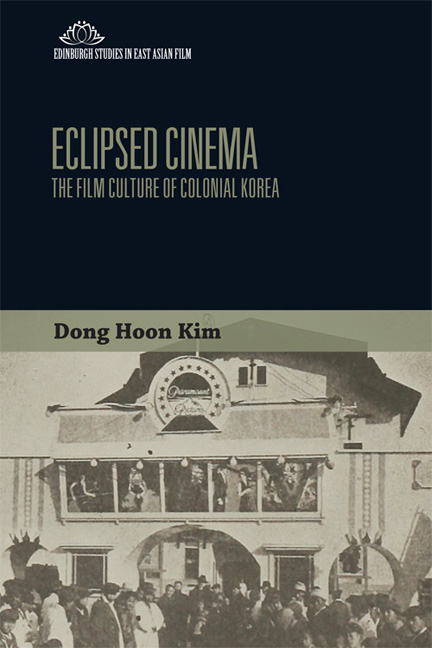Book contents
- Frontmatter
- Contents
- List of Figures
- Acknowledgements
- Introducing Joseon Cinema: the Question of Film History and the Film Culture of Colonial Korea
- 1 The Beginning: Towards a Mass Entertainment
- 2 Joseon Cinema, Cinematic Joseon: on Some Critical Questions of Joseon Cinema
- 3 Migrating with the Movies: Japanese Settler Film Culture
- 4 Colonial Film Spectatorship: Nationalist Enough?
- 5 Film Spectatorship and the Tensions of Modernity
- Conclusion: Integrating into the Imperial Cinema
- Notes
- Appendix
- Bibliography
- Index
2 - Joseon Cinema, Cinematic Joseon: on Some Critical Questions of Joseon Cinema
Published online by Cambridge University Press: 03 January 2018
- Frontmatter
- Contents
- List of Figures
- Acknowledgements
- Introducing Joseon Cinema: the Question of Film History and the Film Culture of Colonial Korea
- 1 The Beginning: Towards a Mass Entertainment
- 2 Joseon Cinema, Cinematic Joseon: on Some Critical Questions of Joseon Cinema
- 3 Migrating with the Movies: Japanese Settler Film Culture
- 4 Colonial Film Spectatorship: Nationalist Enough?
- 5 Film Spectatorship and the Tensions of Modernity
- Conclusion: Integrating into the Imperial Cinema
- Notes
- Appendix
- Bibliography
- Index
Summary
In Joseon film history, this period was the time when film productions began to form. You could see the signboards of production companies everywhere when strolling down the streets of Gyeogseong [Seoul]. The sentiment for cinema was greatly expanding. However, there were few good movies, and people loaded with money only aspired to become actors or directors, always chanting, ‘Production!’ ‘Production!’ This period nonetheless was the time when the foundation for Joseon cinema was laid down.
The popular magazine Samcheolli's account of Joseon cinema of the second half of the 1920s demonstrates the plight of film-making in which hopes and uncertainties coexisted at the nascent stage of commercial film production in colonial Korea. As mentioned in the preceding chapter, two decades after the cinema's arrival, film production for profit finally took off in Joseon, and the immense success of early productions lured aspiring film-makers to pursue film-making professionally. These pioneers, however, found themselves caught in an array of challenges, many of which they could not overcome for many years to come. Owing to lack of financial investment, film production companies were constantly being established only to disband after – or even before – a single project. All film-makers had to share two used film cameras, and it was common for them to film their movies on positive film instead of negative film because of the difficulties of acquiring film stock or securing enough funding and facilities for the post-production. In the absence of film studios, films were shot entirely on location in the daytime and no film-maker could afford a lighting system; underlit scenes in Joseon films became a major source of frustration for film fans, and close-ups were rarely used because of the unavailability of lighting. Film censorship codes which were systematically implemented in this decade were just one of many hardships early film-makers had to endure. ‘I wept for the superhuman efforts of Joseon film-makers who shot fourteen reels of film with only a single 1927 Willard camera and an insufficient lighting system and also hand-washed eighteen thousand feet of film at a storage-like processing lab for a year and a half’, a Seoul correspondent for Japanese film magazine Kinema junpō reported with empathy.
- Type
- Chapter
- Information
- Eclipsed CinemaThe Film Culture of Colonial Korea, pp. 55 - 102Publisher: Edinburgh University PressPrint publication year: 2017



